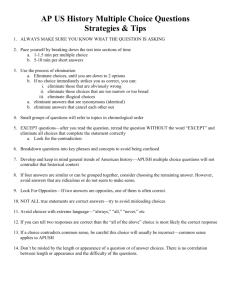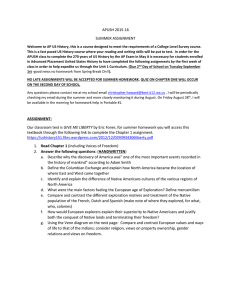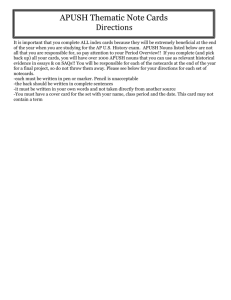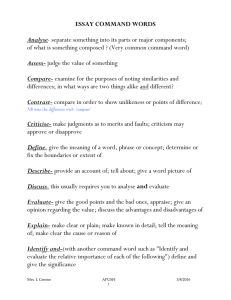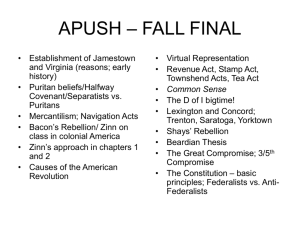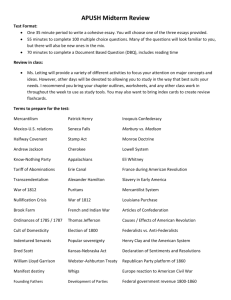APUSH intro to course 2014
advertisement
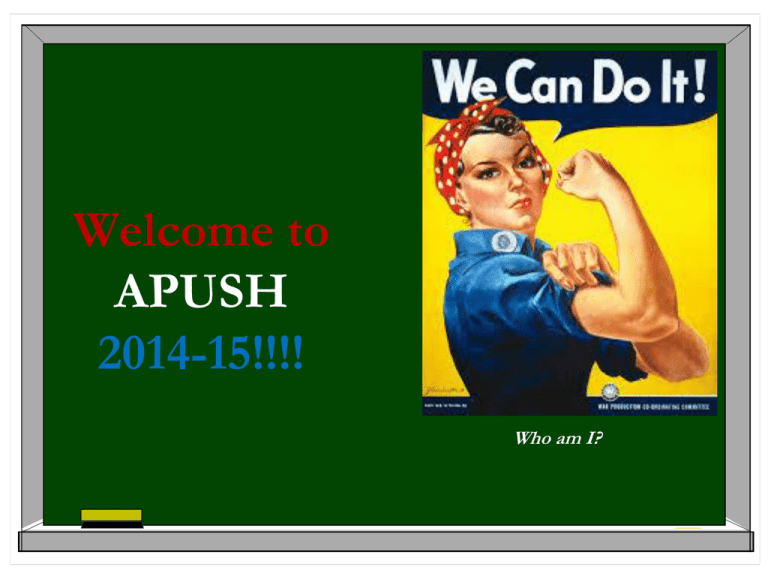
Welcome to APUSH 2014-15!!!! Who am I? Goals for Today… Understand how AP courses work Understand the APUSH Exam Understand our approach to class Administrative stuff…. Why take an AP course? Do college level work and earn…. a +0.4 GPA bump (i.e. B+ = 3.9 not 3.5) “props” on the MMA transcript for the college resume potentially college credit ($$) an opportunity to develop critical thinking skills necessary for college success How do I get college credit? Successfully complete the class Take the standardized AP Exam (yes, produced by the College Board : the same folks that torture you with the SAT ) Exam scored on a 1 to 5 scale Scores of 5, 4 or 3 may earn credit but it is at each college’s discretion earn Sound easy enough???? Statistics from the 2014 exam to consider 2.3 million total AP exams / avg. score 2.83 383,000 APUSH exams / avg. score 2.92 APUSH Scores 11% Scored 5 21% Scored 4 21% Scored 3 27 % Scored 2 20% Scored 1 What do these numbers tell you???? Brainstorm Questions….. Why is this course/ this exam so demanding? What skills do I need to develop to earn a 4 or 5? The rigor of APUSH Content Over 400 years of history (breath) Detail historical analysis demanding (depth) interpretation contextualization analysis synthesis argumentation The 2015 Exam ( 3hrs 15 minutes : D-day(5/8/15) Part 1: Multiple choice 55 questions, 55 minutes = 40% of exam Part 2: Short Answers 4 questions in 45 minutes = 20% Part 3: DBQ (Documents Based Question) 1 question in 60 minutes = 25% Part 4: Long Essay 1 of 2 questions in 55 minutes = 15% (Questions : 1) Breath or depth? 2)How is 2015 different than 2014?) The Redesign’s Approach Concepts …. are stressed over rote memorization; “depth” over “breath.” Themes …. “package” the content covered in the nine time periods so it can be studied conceptually. Thinking Skills … are to be the focus of the class. Different sections of the APUSH exam will explicitly or implicitly test each of these nine skills. The Goal of the Course “The course is designed to encourage students to become apprentice historians who are able to use historical facts and evidence in the service of creating deeper conceptual understandings of critical developments in U.S. history.” College Board, The AP US History Curriculum Framework : Fall, 2014, pg. 9 Time Periods & Concepts Course is divided into 9 different time periods Each time period has 3 key concepts and supporting subconcepts APUSH Themes Historical Thinking Skills Our Approach: The Museum Analogy Preview for breath Discuss within concepts and themes Explore with illustrative examples Explain with historical thinking skills Who am I? Time period? Occupation? Insight from image? What’s the tone? Who drew the picture? For what reason? What is happening in the US at this time? In the world? How does the image compare to the generation of women before her? After? Basic Weekly Timeline Monday: Tuesday: Group work on concepts and content map (AKA study guides) Wednesday: Quiz on last week’s content and concepts Introductory lecture to this week’s content and concepts Class discussion concepts and content map APUSH Skill building exercise(s) Introduction to illustrative examples assignment Thursday and Friday: Illustrative examples exercises Administrative Stuff Syllabus Review Textbooks Technology Use Contracts Student Information Forms HW Assignment
